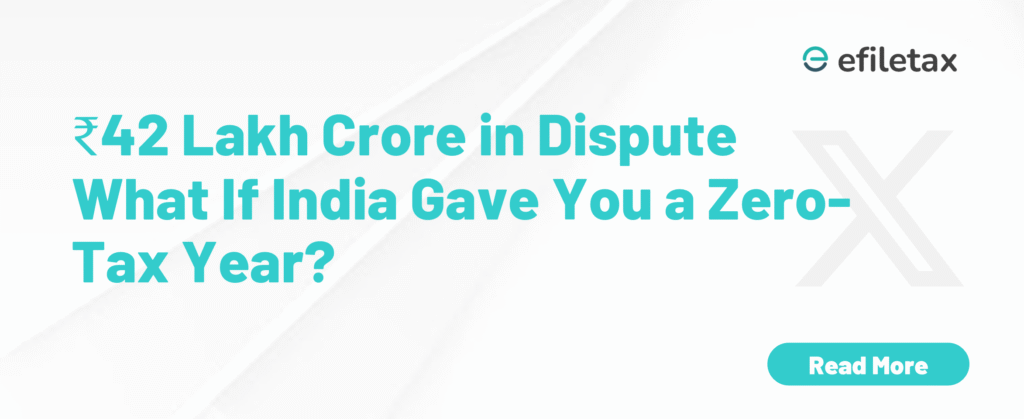
India’s Income Tax Demand Hits ₹42 Lakh Crore: What It Means for You
As of October 2024, India’s outstanding income tax demand has ballooned to ₹42 lakh crore—quadrupling from ₹10 lakh crore in 2020. The Income Tax Department has set a recovery target of ₹27 lakh crore this year, which is nearly equivalent to the total income tax collection budget of the Government of India for FY 2024–25.
This raises three important questions:
- Why is the demand piling up?
- Is such recovery realistic?
- What should taxpayers expect?
Let’s break it down.
What is ‘Outstanding Income Tax Demand’?
Outstanding demand means the tax amount that:
- The Assessing Officer (AO) has raised in a notice
- Is pending due to litigation, reassessment, appeal, or stay orders
- Has not been paid by the taxpayer
It includes:
- Disputed tax under appeal
- Confirmed tax under recovery
- Penalties and interest
👉 Source: CBDT Annual Report 2023–24 and RTI replies quoted in PIB data
Breakup of ₹42 Lakh Crore Demand (Approx. as of Oct 2024)
| Component | Amount (₹ Lakh Cr) |
|---|---|
| Under litigation (CIT(A), ITAT, HC/SC) | 22.5 |
| Not under dispute (pending collection) | 12.3 |
| Stay granted or pending verification | 7.2 |
| Total | 42.0 |
This also includes big-ticket disputes involving corporates, multinationals, and retrospective tax cases (like Vodafone, Cairn, etc.).
Can ₹27 Lakh Crore Really Be Recovered?
Unlikely. Here’s why:
- Over 50% of demand is under litigation — pending for years at CIT(A), ITAT, or Courts.
- Recovery powers under Section 222 of the Income Tax Act are limited when appeals are active.
- Interest and penalty inflate the figures, but actual principal tax may be lower.
- Much of the demand is untraceable, uncollectible, or against companies that are defunct, struck-off, or insolvent.
Expert View:
Tax lawyer Ajay Wadhwa says, “Only about 20–25% of total demand is realistically recoverable, unless the government launches a fresh settlement scheme like Vivad se Vishwas 2.0.”
Why Is the Demand Growing So Fast?
- Aggressive assessments post faceless scrutiny
- Legacy disputes from pre-GST and pre-digital era
- Delays in appellate disposal – CIT(A) backlog runs into lakhs of cases
- TDS mismatches, foreign income disputes, and high-pitched additions
- Penalty notices and interest accumulation on small unpaid demands
What Can Be Done?
Here are 5 practical options to fix the ₹42 lakh crore tax mess:
- Litigation Amnesty 2.0 – A fresh dispute settlement scheme under Section 245M
- Time-bound disposal of CIT(A) and ITAT cases with AI support
- Remove uncollectible demand (per Rule 12 of the Central Receipts & Disbursement Rules)
- Auto-adjustment limits to ignore demands below ₹1,000 (per CBDT Circular No. 2/2024)
- One-time write-off policy for demands over 10 years old
Do Taxpayers Get Any Relief?
Technically, no. The unpaid demand is still a liability, even if under dispute.
But here’s what you can do:
- File Form 35 timely if under appeal
- Respond to IT notices within 30 days (per Section 156 read with Rule 15A)
- Seek stay if demand is unjust or appeal is strong (CBDT Instruction No. F. No. 404/72/93-ITCC)
- Use the e-Verify Demand Portal to track and resolve notices
So, Can the Govt Waive Tax Next Year?
Nice thought, but zero tax for a year is not fiscally feasible. Here’s why:
- Income Tax is ~25% of total government revenue
- ₹27 lakh crore recovery = one-time boost, not a recurring income
- Even if full demand is collected, waiver of tax may break revenue discipline
Instead, the government might consider:
- Lower tax on middle class (under Section 115BAC)
- Incentives for timely compliance and clean records
Key Takeaways
- Income tax demand is at a historic high of ₹42 lakh crore
- Much of it is stuck in litigation and may not be recovered
- Taxpayers must regularly check and verify their demand status
- Relief is possible through structured amnesty or faster appellate resolution
Summary
India’s outstanding income tax demand hit ₹42 lakh crore in October 2024. Over 50% is under litigation, making the ₹27 lakh crore recovery target unrealistic. Experts call for faster appeal disposal and a new dispute settlement scheme. Taxpayers must actively respond to notices and track their demand status online.
FAQ Section
Q1. Is all outstanding tax demand recoverable?
No. Over half is under litigation, and a large portion is untraceable or time-barred.
Q2. Will the government launch another tax amnesty scheme?
It’s possible. Experts suggest a Vivad se Vishwas 2.0 to resolve legacy disputes.
Q3. Can I ignore an old demand notice?
No. Even small or disputed demands must be responded to via portal or appeal.
Need help checking or responding to tax demand notices?
Efiletax experts can assist you with demand verification, appeals, and settlement options. Let’s simplify your tax life.